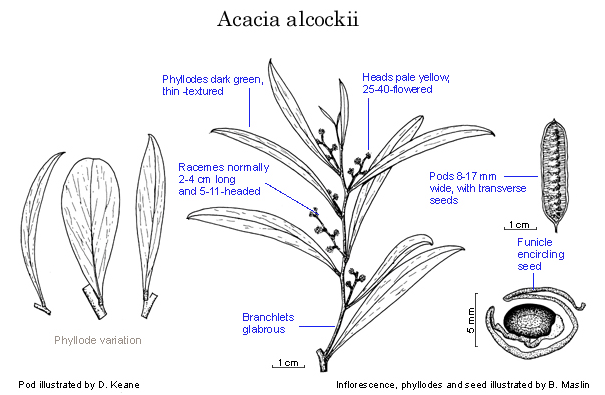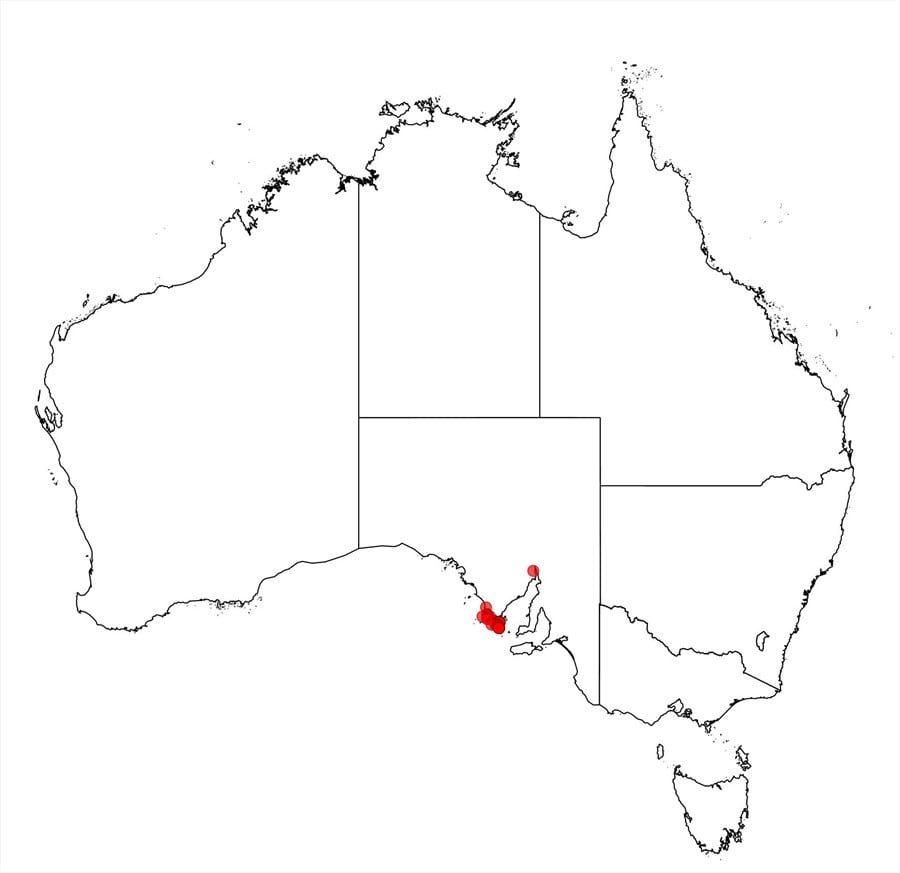Acacia alcockii Maslin & Whibley
WATTLE
Acacias of Australia
Family
Fabaceae
Distribution
Occurs in several areas at the southern extemity of Eyre Peninsula, S.A., namely along the south-western coast between Mt Drummond and Mt Dutton and on the south-eastern coast between Billy Light Point to West Point in the Lincoln Natl Park.
Description
Bushy shrub to c .3 m high, often suckering. Branchlets dark reddish, glabrous. Phyllodes on short stem-projections, narrowly elliptic to oblanceolate, straight to shallowly recurved, mostly 6–9 cm long and 8–21 mm wide, narrowed at base, acute to acuminate and subuncinate, infrequently obtuse, thin, glabrous, 1-nerved per face, obscurely penninerved; gland normally 8–12 mm above pulvinus; pulvinus 2–6 mm long. Inflorescences mostly 5–11-headed racemes; raceme axes (1.5–) 2–4 (–5) cm long, glabrous; peduncles (3–) 4–5 mm long, 8–10 mm long when peduncles not in racemes (rare); heads globular, 25–40-flowered, pale yellow. Flowers 5-merous; sepals c. 5/6-united. Pods oblong to narrowly oblong, straight-edged to constricted between seeds, flat, to c. 9 cm long but often shorter, 8–17 mm wide, coriaceous to crustaceous, occasionally subwoody, glabrous. Seeds transverse, oblong-elliptic, 5–6 mm long, ±dull, black; funicle encircling seed in a double fold, light red-brown; aril clavate.
Habitat
Normally grows in sand over limestone in mallee communities, sometimes with Melaleuca spp.
Specimens
S.A.: ‘Pillie Lakes’, c. 15 km S of Port Lincoln, C.R.Alcock 1256 (AD, NSW, PERTH); Stanford Hill, roadside through Lincoln Natl Park, C.R.Alcock 3279 (CANB n.v., NSW, PERTH); Near Billy Light Point, Port Lincoln, D.E.Symon 6693 (AD).
Notes
Plants from Port Lincoln and the northern part of the Lincoln Natl Park (i.e. Stamford Hill and Cape Donnington Peninsula) have normally shallowly recurved phyllodes 8–11 mm wide and thin to moderately coriaceous pods to 7–9 cm long and 8–12 mm wide. In the southern part of the Park (i.e. West Point, Memory Cove and Jussieu Bay) the phyllodes are normally straight and 12–21 mm wide, and the pods to 3.5–5 cm long, 12–17 mm wide and moderately coriaceous to ±crustaceous or subwoody. The northern populations may represent a stabilised hybrid involving probably A. anceps and A. leiophylla while the southern populations may represent a spontaneous hybrid between these putative parents, fide B.R.Maslin & D.J.E.Whibley, Nutysia 6: 22–23 (1987).
Acacia alcockii is a member of the ‘Acacia microbotrya group’ distinguished from A. anceps and A. leiophylla by a combination of its racemose inflorescences and transverse seeds. It is similar to A. notabilis which has thicker, grey-green to glaucous phyllodes and bright golden flower-heads.
FOA Reference
Data derived from Flora of Australia Volumes 11A (2001), 11B (2001) and 12 (1998), products of ABRS, ©Commonwealth of Australia
Author
B.R.Maslin
Minor edits by J.Rogers
This identification key and fact sheets are available as a mobile application:
URL: https://apps.lucidcentral.org/wattle/
© Copyright 2018. All rights reserved.










